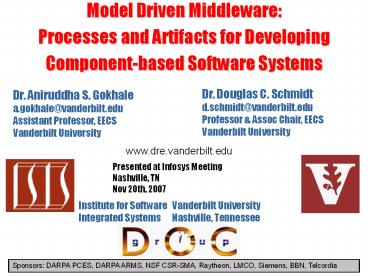Model Driven Middleware: Processes and Artifacts for Developing Component-based Software Systems - PowerPoint PPT Presentation
Title:
Model Driven Middleware: Processes and Artifacts for Developing Component-based Software Systems
Description:
Model Driven Middleware: Processes and Artifacts for Developing Component-based Software Systems Dr. Douglas C. Schmidt d.schmidt_at_vanderbilt.edu – PowerPoint PPT presentation
Number of Views:148
Avg rating:3.0/5.0
Title: Model Driven Middleware: Processes and Artifacts for Developing Component-based Software Systems
1
Model Driven Middleware Processes and Artifacts
for Developing Component-based Software Systems
Dr. Douglas C. Schmidt d.schmidt_at_vanderbilt.edu P
rofessor Assoc Chair, EECS Vanderbilt University
Dr. Aniruddha S. Gokhale a.gokhale_at_vanderbilt.ed
u Assistant Professor, EECS Vanderbilt University
www.dre.vanderbilt.edu
Presented at Infosys Meeting Nashville, TN Nov
20th, 2007
Sponsors DARPA PCES, DARPA ARMS, NSF CSR-SMA,
Raytheon, LMCO, Siemens, BBN, Telcordia
2
Landscape of Large Software Systems
- Network-centric and large-scale systems of
systems - e.g., industrial automation, emergency response,
healthcare, transportation, banking - Heterogeneity
- Different communication semantics
- Different platforms
- Satisfying tradeoffs between multiple (often
conflicting) QoS demands - e.g., secure, real-time, reliable, etc.
Systems increasingly adopting service oriented
architectures
3
Technology Enablers for Composable Software
Write Code That Reuses Code
- Components encapsulate application business
logic - Components interact via ports
- Provided interfaces, e.g., facets
- Required connection points, e.g., receptacles
- Event sinks sources
- Attributes
- Containers provide execution environment for
components with common operating requirements - Components/containers can also
- Communicate via a middleware bus and
- Reuse common middleware services
4
Challenges in Developing Software Systems (1/2)
- Developers must develop high quality, high
confidence software
- Must deal with changes in development platforms
- e.g., middleware, protocols, networks, OS,
hardware - Steep learning curve
- Different approaches to development, deployment,
configuration and testing
- Time-to-market pressures continue to increase
5
Challenges in Developing Software Systems (2/2)
- Variability in the problem space (domain expert
role) - Functional diversity
- Composition, deployment and configuration
diversity - QoS requirements diversity
6
Steps in Realizing Composable Software Systems
7
Solution Approach Model Driven Engineering (MDE)
- Develop, validate, standardize generative
software technologies that - Model
- Analyze
- Synthesize
- Provision
- multiple layers of middleware application
components that require simultaneous control of
multiple quality of service properties end-to-end - Processes for inter-/intra-layer optimization
advanced product-line architectures
ltCONFIGURATION_PASSgt ltHOMEgt ltgt
ltCOMPONENTgt ltIDgt ltgtlt/IDgt
ltEVENT_SUPPLIERgt ltevents this
component suppliesgt lt/EVENT_SUPPLIERgt
lt/COMPONENTgt lt/HOMEgt lt/CONFIGURATION_PAS
Sgt
Goal is not to replace programmers per se it is
to provide higher-level domain-specific languages
for middleware/application developers users
8
Leveraging Standards OMG DC Specification
- Specification Implementation
- Defining, partitioning, implementing appln
functionality as standalone components - Assembly Packaging
- Bundling a suite of software binary modules
metadata representing app components - Installation
- Populating a repository with packages required by
app - Configuration
- Configuring packages with appropriate parameters
to satisfy functional systemic requirements of
an application without constraining to physical
resources - Planning
- Making deployment decisions to identify nodes in
target environment where packages will be
deployed - Preparation
- Moving binaries to identified entities of target
environment - Launching
- Triggering installed binaries bringing appln to
ready state - QoS Assurance Adaptation
- QoS validation, runtime (re)configuration
resource management to maintain end-to-end QoS
OMG Deployment Configuration (DC)
specification (ptc/05-01-07)
9
Our MDE Solution CoSMIC Tool chain
- CoSMIC tools e.g., PICML used to model
application components, CQML for QoS - Captures the data model of the OMG DC
specification - Synthesis of static deployment plans for DRE
applications - Capabilities being added for QoS provisioning
(real-time, fault tolerance, security)
CoSMIC can be downloaded at www.dre.vanderbilt.edu
/cosmic
10
DOC Group Research on Software Systems
Multiple Levels of Abstraction
- CoSMIC - Modeling Deployment Configuration
(DC) crosscutting concerns
- RACE Resource and Control Engine
- DAnCE Deployment And Configuration Engine
- CIAO QoS-enabled component middleware
www.dre.vanderbilt.edu
11
Research Impact Future Work
Advanced MDE
Current progress stems from years of iteration,
refinement, successful use
CoSMIC
Model driven middleware
Shape the standards e.g., OMGs Model Driven
Architecture (MDA) for DRE systems
RT/CCM
ACETAO
CORBA Component Model (CCM)
Component Models (EJB)
- Long-term Research Directions
- Heterogeneous component systems
- Automated QoS configurations
- Feature modeling
- Runtime model feedback
- Automated inference of bottlenecks
- Synthesis of QoS management policies
- Synthesis of autonomic survivability
Real-time (RT) CORBA
CORBA DCOM
DCE
Micro-kernels
RPC
Internet
1970
2010
2000
2005
Year
12
Team Members and Collaborators
This research was possible due to our sponsors,
efforts of students, and collaborations
- Collaborations
- Dr. Doug Schmidt
- Dr. Janos Sztipanovits
- Dr. Gabor Karsai
- Dr. Joe Loyall
- Dr. Rick Schantz
- Dr. Joe Cross
- Dr. Sylvester Fernandez
- Dr. Adam Porter
- Dr. Sherif Abdelwahed
- Dr. Jeff Gray
- Dr. Swapna Gokhale
- Dr. Cemal Yilmaz
- Thomas Damiano
- Christopher Andrews
- Theckla Louchios
- Current/Past DOC Students Staff
- Krishnakumar Balasubramanian
- Arvind Krishna
- Jaiganesh Balasubramanian
- Emre Turkay
- Jeff Parsons
- Balachandran Natarajan
- Sumant Tambe
- James Hill
- Akshay Dabholkar
- Amogh Kavimandan
- Gan Deng
- Will Otte
- Jules White
- Joe Hoffert
- George Edwards
- Dimple Kaul
- Arundhati Kogekar
- Gabriele Trombetti
- Sponsors DARPA PCES, DARPA ARMS, NSF CSR-SMA,
Raytheon IRAD, LMCO, Siemens, BBN, Telcordia
13
Concluding Remarks
- Model-Driven Engineering (MDE) is an important
emerging generative technology paradigm that
addresses key lifecycle challenges of DRE
middleware applications - OMG PSIG on Model Integrated Computing
www.omg.org/news/meetings/tc/ agendas/mic.htm
Many hard RD problems with model-driven
engineering remain unresolved!!
- CoSMIC MDE tools are based on the Generic
Modeling Environment (GME) - CoSMIC is available from www.dre.vanderbilt.edu/co
smic - GME is available from www.isis.vanderbilt.edu/Proj
ects/gme/default.htm

